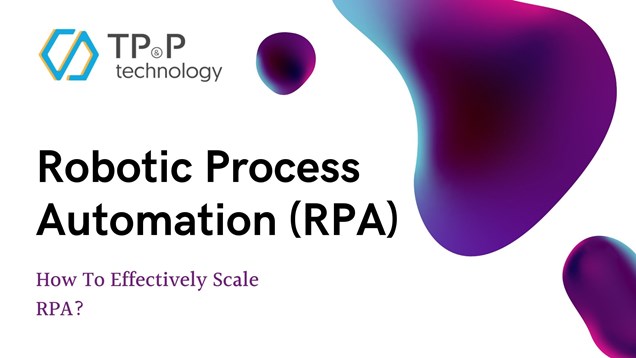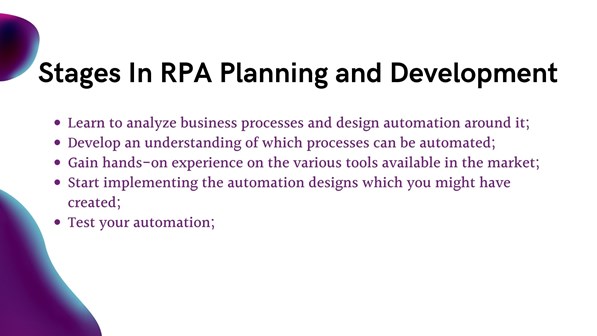
Robotic Process Automation (RPA) Post Implementation: How To Scale Effectively?
There is a big move towards automation in recent years, as robotic process automation (RPA) has a great potential in streamlining business processes and operations. RPA is surely a solution to not only save costs but also time.
Whether it's big enterprises or small businesses, they are all aiming to automate its process in a way that complements the manual strategizing, and processes remain uninterrupted.
With RPA pilots everywhere, it’s a challenge for IT departments and shared service centers (SSCs) to create their RPA initiatives at an industrial scale. 
Enterprises need to redesign their approach such as operations, processes, tooling, and infrastructure in order to increment RPA on a large scale.
Generally speaking, in order to plan and develop an RPA project, we need to:
- Learn to analyze business processes and design automation around it;
- Develop an understanding of which processes can be automated;
- Gain hands-on experience on the various tools available in the market;
- Start implementing the automation designs which you might have created;
- Test your automation;
Even though it is deemed that the gap will lie in the implementation phase, due to various reasons such as lack of professional RPA developers and specialists.
There is also a big gap in RPA services capabilities lying in the post-implementation phase instead, including performance and scalability.
Here are 5 ways to fill the gap and meet the key challenges.
Begin with the End in Mind
It is mentioned in the book ‘The 7 Habits of Highly Effective People’ by Stephen Covey that the second habit (Begin with the End in Mind) is how you can achieve what you want.
The idea is “based on the principle that all things are created twice”. Professional athletes visualize their moment of winning a competition, how they do it, before they even do it.
Ted Williams, one of the greatest American professional baseball players of all time used to practice his swing in the mirror every day, before his real game, this process had brought him the status he earned till today. It all began with the end in mind.
It is essential to understand the result so you can focus time and energy on the right thing. Beginning with the end in mind can help you in many ways since it keeps you have your eyes on the prize.
Having a clear vision, direction, and destination and start looking at the operating model strategy that will support the bots.
A clear operating strategy can help encourage the IT department to make technical resources and to support available human resources, distribute software and robot scripts, manage the configuration as well as provide and maintain security access.
This is rather a long and effort needed process.
Constructing a business continuity plan
Digitization creates opportunities for enterprises to speed up their workflows, save cost, and increase productivity and RPA is surely a solution for reducing time and responding to incidents, and minimizing the risk of being exposed to incoming attacks.
However, digital transformation and hyper-convergence also are gateways to risks, vulnerabilities, attacks, and failure and it is a risk not having anything to back up if you only rely on one single source of infrastructure.
A business continuity plan (BCP) is a document outlining how a business can operate during an unplanned disruption in service.
If the system goes down, the bots need to be re-started along with the software stack: operating system, architectural layers, protocols, run-time environments, databases, and functions calls.
This plan is a checklist including supplies and equipment, data backups and backup site locations, contact information for emergency responders, key personnel, and backup site providers. BDP can provide detailed information and strategies on how business operations can be maintained.
Enterprises nowadays are more aware of their vulnerability to cyber threats that can permanently destroy its IT systems. Some organizations create mirrored environments so that they can switch to in case of system failures.
Leveraging Cloud Computing
To accelerate RPA, the technology must be widely accessible and easily scalable, so that businesses with no technology background can create their own function-specific software bots.
Cloud computing has become a foundational piece for modern IT architecture since nearly half of companies worldwide state that 31 percent to 60 percent of their IT systems are cloud-based.
Cloud provides extra bots with one click as well as enables efficient, consumption-based models. With a single drag-and-drop motion, users can easily automate the jobs which don’t require human creativity, problem-solving skills, empathy, or judgment as it operates as a self-service technology.
If you’re working in critical industries like banking or defense, consider private-cloud as it is a virtual barrier that segregates any portion of your company’s assets from the rest, which protects your RPA.
Incorporate Security Policies
Corporate security policies ensure enterprise to have a baseline for performing security-related duties based on its enterprise’s information security requirements. The policies can be extended beyond the borders of the IT department and involve others like Human Resource, Finance, Legal departments. The policies need to reflect the new complexities.
Constant Change is a Rule
When it comes to bots, constant change is a must.
Many times, RPA investments often don’t progress past test and development because of the governance roadblocks.
In this case, most enterprises would establish a center of excellence within the organization so that they can manage the work, policies, governance, and tool/vendor selection for RPA.
Or, when a third party involved like tool vendors, RPA consultants, or business process outsourcing providers can totally change the business landscape. The business owner has to make different decisions regarding not only external business-related decisions but also internal one, in this case, RPA, if they want to improve the productivity within their organization.
Conclusion
And there are many more issues that need to be tackled. And especially if it’s digital transforming your business, you need to think right, think fast, flexible, and open to change.In a nutshell, RPA allows enterprises to automate a variety of tasks just like a human being, helping businesses to save cost, time, and human resources in repetitive tasks. At the same time, the average productivity of the Robot is 100 without any errors, they can also handle multiple tasks very well.
RPA can be applied in various industries such as healthcare (patient registration and billing), HR (new employee joining formalities, payroll process, and hiring shortlisted candidates), Travel and logistics (Ticket booking, passenger details, and accounting), and so on.
With the help of RPA, large numbers of processes can be automated easily, allows time for other human needed tasks, and because it is easy to use, non-technical staff, can set up a bot and record their steps to automate the process.
However, implementing RPA at scale is a difficult task. At TP&P Technology, we offer help in scaling up your RPA digital workforce, focusing on better operating model design, and a better cloud-based platform. Talk to one of our experts today!



